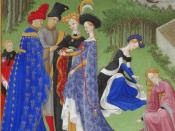Political chaos and the blending of different cultures and beliefs have always been catalysts to human creativity ÃÂ consider PicassoÃÂs, Guernica (Getlein, p. 60) or the rich musical history of the African-American culture which has its roots in upheaval, forced slavery, and finally re-establishment, mixing old traditions with new. The changes seen in the art of southern Europe were inevitable and could definitely be at least partially attributed to old culture meeting new. Many social and religious changes were afoot in Renaissance Italy, not the least of which was economic stability. Banking had been established and a newly affluent class emerged competing with each other and the Church to hire the most talented artists of the region (Getlein, p. 395).
Renaissance means ÃÂrebirthÃÂ (Getlein, p. 393) and surely living among the ruins of ancient Greece and Rome was bound to, at some point, ignite a revival of these extremely advanced cultures and the ideas and talent they embodied.
It seems very natural that revisiting earlier art and texts of the geographic region would foster growth on both the artistic and intellectual fronts of Italy. Additionally, as the iron grip of the church relaxed, art seemed to move away from ÃÂdivineÃÂ subjects to those more tangible, though some of the greatest works of the Renaissance such as DonatelloÃÂs St. Mark and MichelangeloÃÂs Sistine Chapel, still held to Christian themes.
Along with Christian themes, artists turned to Greek and Roman mythology for inspiration as well as everyday scenes. GiorgioneÃÂs, The Tempest is an example of art for artÃÂs sake ÃÂ the artistÃÂs appreciation for nature is evidenced by the finely detailed landscape, though the nude woman sitting under a tree breast-feeding her infant while being watched by a soldier gives one pause as to what the underlying meaning of the scene is,


